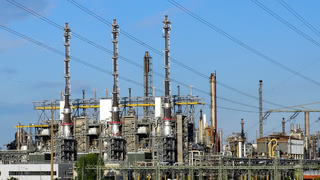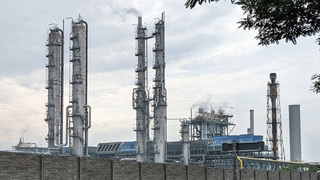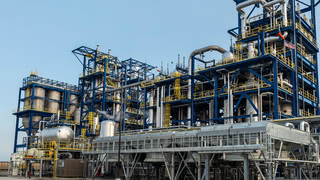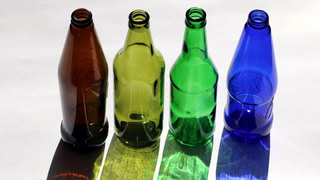The avoidable Super-Greenhouse-Gas from Fertilizer, Nylon, and Vitamin B3 production
The production of some nitrogen-based chemicals can cause substantial nitrous oxide emissions (N₂O), a potent greenhouse gas. Technology to stop these emissions is cheap and readily available, but it is not always applied.
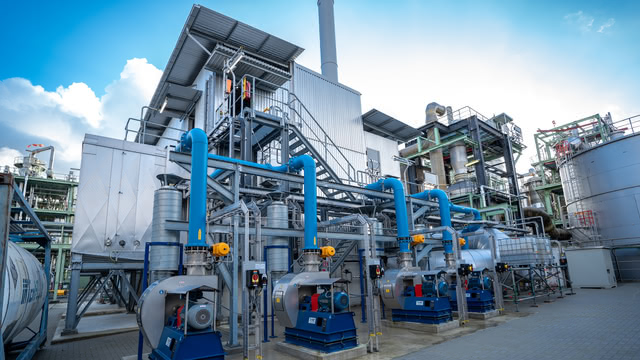
Nitrous oxide or N₂O, also called laughing gas, is the third-most important greenhouse gas after carbon dioxide and methane. Its global warming potential is 270, which means that one ton of nitrous oxide is as damaging to the climate as 270 tons of carbon dioxide. Therefore, even modest amounts of N₂O emissions have a significant warming effect. Most N₂O emissions come from agriculture, but they are difficult to avoid without substantial changes in agricultural practices.
Another major source of N₂O emissions is the chemical industry, where the production of some nitrogen-based chemicals causes significant amounts of N₂O. Technologies to avoid these emissions are relatively affordable and have been available since the 1990s, and many plants use these successfully.
Two major technology options for N₂O abatement are available: Catalytic converters that chemically turn N₂O into harmless substances and thermal decomposition, which breaks the gas down under high temperatures. Avoiding the equivalent of a ton of CO₂ with N₂O abatement technology usually costs less than five dollars. The costs are often below one dollar for the easiest to avoid emissions.
That is extremely cheap. For other climate mitigation technologies, costs between 30 and 100 Euro per ton of carbon dioxide are not unusual. But despite these low costs, N₂O abatement technology is not used consistently.
A German government-funded initiative wants to transform the Nitric Acid sector
The main source of industrial N₂O emissions is the production of nitric acid, a chemical used in the production of fertilizers. In 2015, the German government initiated the Nitric Acid Climate Action Group (NACAG), which, according to its description, aims "to promote the installation of effective N₂O abatement technology in every nitric acid plant worldwide."
The Nitric Acid Climate Action Group is seeking partnerships with other countries that commit to avoiding N₂O emissions in their nitric acid industry. NACAG offers to fund the initial costs to install N₂O abatement technology for nitric acid producers in developing countries.
NACAG is now collaborating with nitric acid producers in various countries, such as Uzbekistan, Mexico, and Zimbabwe. Part of those collaborations is an agreement with the countries that commit to implementing policy or regulation for N₂O abatement in the nitric acid industry.
The latter part is crucial and separates it from previous initiatives for N₂O abatement in international climate policy. As part of the Kyoto Protocol, the first UN climate treaty, a funding instrument called the Clean Development Mechanism (CDM) was implemented. Industrialized countries could fund emission reduction projects in developing countries and count those towards their own reduction goals.
Due to its low costs, N₂O abatement was an attractive target for Clean Development Mechanism projects, at nitric acid plants and production facilities for adipic acid, another chemical with high N₂O emissions. It is used to produce nylon fibers. Many of these projects happened in China.
In many cases, these abatement technologies were installed with funding from the Clean Development Mechanism, only to be abandoned after funding via this instrument stopped. Today, China has the world's largest adipic acid industry, and most emissions are not abated. (The story of adipic acid plants in China and the Clean Development Mechanism was covered in detail by Inside Climate News in 2020, which I strongly recommend reading.)
NACAG, which only focuses on nitric acid and currently does not target adipic acid plants or other chemicals, tried to learn from those mistakes. By coupling financial support with a political commitment to regulating emissions from nitric acid, they hope to achieve a more durable reduction of emissions than previous initiatives.
Even in industrialized countries, the use of N₂O abatement technology is not consistent. Regulation is patchy and sometimes lacking. A study by the German research organization Öko-Institut and commissioned by NACAG analyzed N₂O mitigation potentials in industrialized countries.
It looked at three chemicals: The already mentioned nitric acid, adipic acid, and a third one, caprolactam, which is also used to produce synthetic fibers.
The study identifies the largest reduction potential in Russia. (The study did not look at what it calls "emerging economies". Notably, it did not look at China.)
Less than half of US Nitric Acid plants avoid their emissions
Second is the United States, where, on a federal level, N₂O emissions are unregulated. Some states have their own regulation, and some companies abate emissions voluntarily or as part of carbon offsetting schemes. But less than half of the nitric acid plants in the United States abate their N₂O emissions.
A curious case is the European Union: N₂O emissions from nitric acid and adipic acid, the two primary sources, are regulated as part of the Emission Trading System (ETS). Companies causing these emissions have to buy emission certificates for them, and given the low cost of abatement compared to emission certificates, this is almost always desirable. It is a success story: Since 2005, when the ETS rules were implemented, emissions from nitric acid were reduced from 137 thousand tons of N₂O to less than 10 tons – with little change in production volumes. Emissions from adipic acid went from 38 tons to less than one ton. (Production volumes are not publicly available.)
Yet, emissions from caprolactam are not part of the ETS. The Directorate-General for Climate Action of the European Commission did not want to comment on the record of why this is the case.
Compared to other emission sources, N₂O emissions from caprolactam are relatively small, likely one reason it is not included in the ETS. But they are not insignificant either.
Despite lacking an EU-wide regulation, some plants have implemented emission reduction measures, either through government funding programs or due to local regulations.
A plant in the Netherlands at the Chemelot industrial park operated by the company Fibrant installed N₂O abatement technology with financial support from the Dutch government in 2021. It reduces emissions equivalent to 600 thousand tons of carbon dioxide - about 0.3 percent of the total emissions from the Netherlands.
In 2021, the company Lanxess announced that it would install technology to reduce the equivalent of 450 thousand tons of carbon dioxide at a plant in Antwerp, Belgium, until 2023 – around half a percent of Belgium's emissions. Caprolactam production only exists in a few countries, but as these examples show, cheap measures at single plants can significantly impact a country's emission profile.
Other caprolactam plants use production processes that do not produce N₂O to begin with. This is, for example, the case at BASF's caprolactam plant in Antwerp. It produces a precursor of caprolactam, a chemical called hydroxylamine, in a different way. "The BASF production process for caprolactam, including hydroxylamine, does not result in N₂O emissions," said Lotte Dierckx, spokesperson of BASF Antwerpen.
A Vitamin factory in Switzerland produced N₂O, and for a long time nobody noticed
Sometimes, emission sources can fly under the radar, as illustrated by the story of a vitamin factory in Switzerland. In 2018, the company Lonza detected N₂O emissions at a factory producing Niacin in the town of Visp. Niacin, also called Vitamin B3, is a food supplement and additive. Its primary use is in animal feed, but it is also part of multivitamin pills and is an ingredient of energy drinks like Red Bull.
Before Lonza detected these emissions by chance, the fact that the plant in Visp was causing N₂O emissions was simply unknown. And they were substantial: The small factory called D29 was responsible for around one percent of Switzerland's greenhouse gas emissions.
The Swiss Federal Office for the Environment (Bundesamt für Umwelt, BAFU) was criticized for its handling of the case, as it has allowed Lonza to continue emitting N₂O without purchasing emission certificates from the Swiss emission trading system for several years. Eventually, Lonza installed a catalytic converter in 2021.
The story of the Swiss niacin emission raises a few questions. Niacin is only produced in a few factories worldwide, yet one wonders whether other factories also produce these outsized amounts of N₂O emissions. Lonza has operated a niacin plant in China, but it has since sold off its niacin business to a company called Arxada. Neither Lonza nor Arxada answered questions on whether the Chinese plant has the same N₂O emission problem as the one in Switzerland.
The second largest niacin producer, the Chinese company Vanetta, says that they use a different production process than the one in Switzerland and that it does not cause N₂O emissions.
The most notable fact about the niacin factory in Switzerland is that these emissions were unknown for decades. It begs the question: Are there other processes in the chemical industry that produce N₂O that nobody knows about?
Low-hanging fruit of emission avoidance
N₂O emissions from the discussed chemical processes are responsible for around 0.2 percent of worldwide greenhouse gas emissions. They are not among the biggest climate polluters, and they aren't even the biggest climate problem of the nitrogen-based chemical industry. (That is the Haber-Bosch process, the production of ammonia from fossil fuel sources, which is the basis for all these processes.)
Yet, given that only a few special processes are responsible for the bulk of these emissions, these industries proportionally have an outsized impact on climate change. Most importantly, due to the very low costs, these emission reduction potentials are the low-hanging fruit of emission avoidance.
Author: Hanno Böck
Updates
- Regular readers will remember my previous reporting about green electricity certificates and their problems with double counting. I am now providing some documents related to guarantees of origin, including a legal analysis of double counting issues in Norway.
